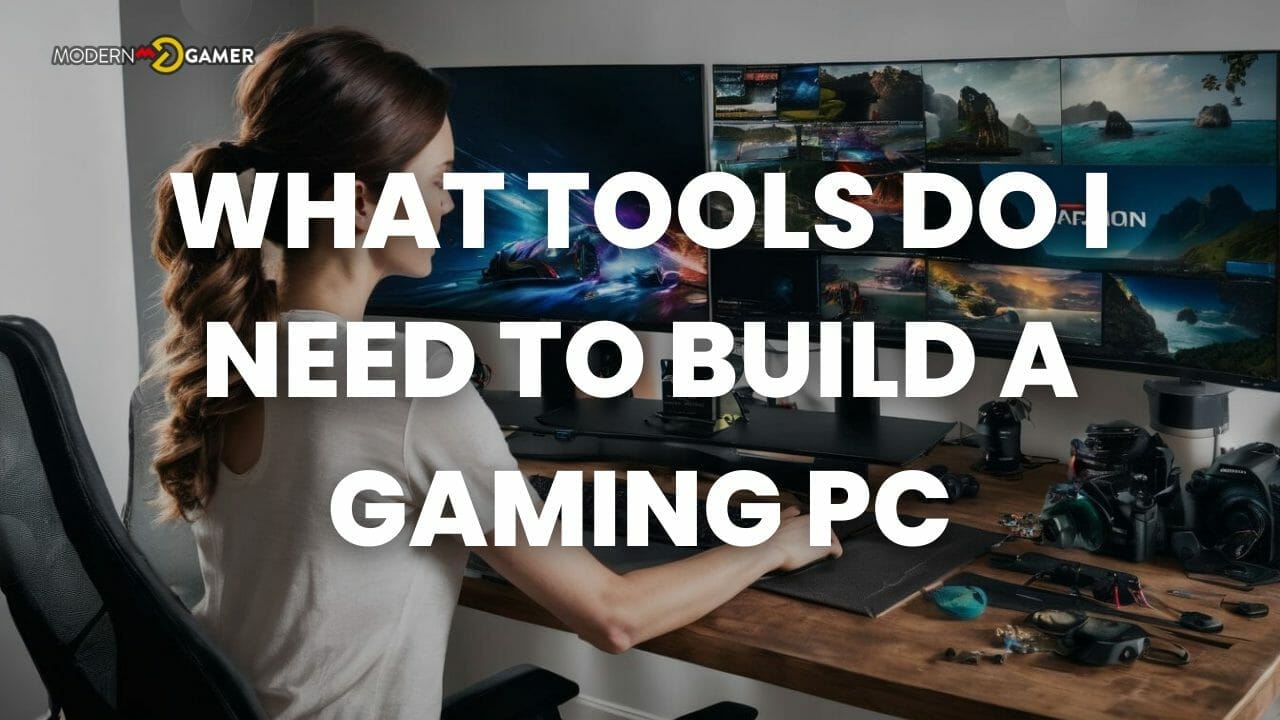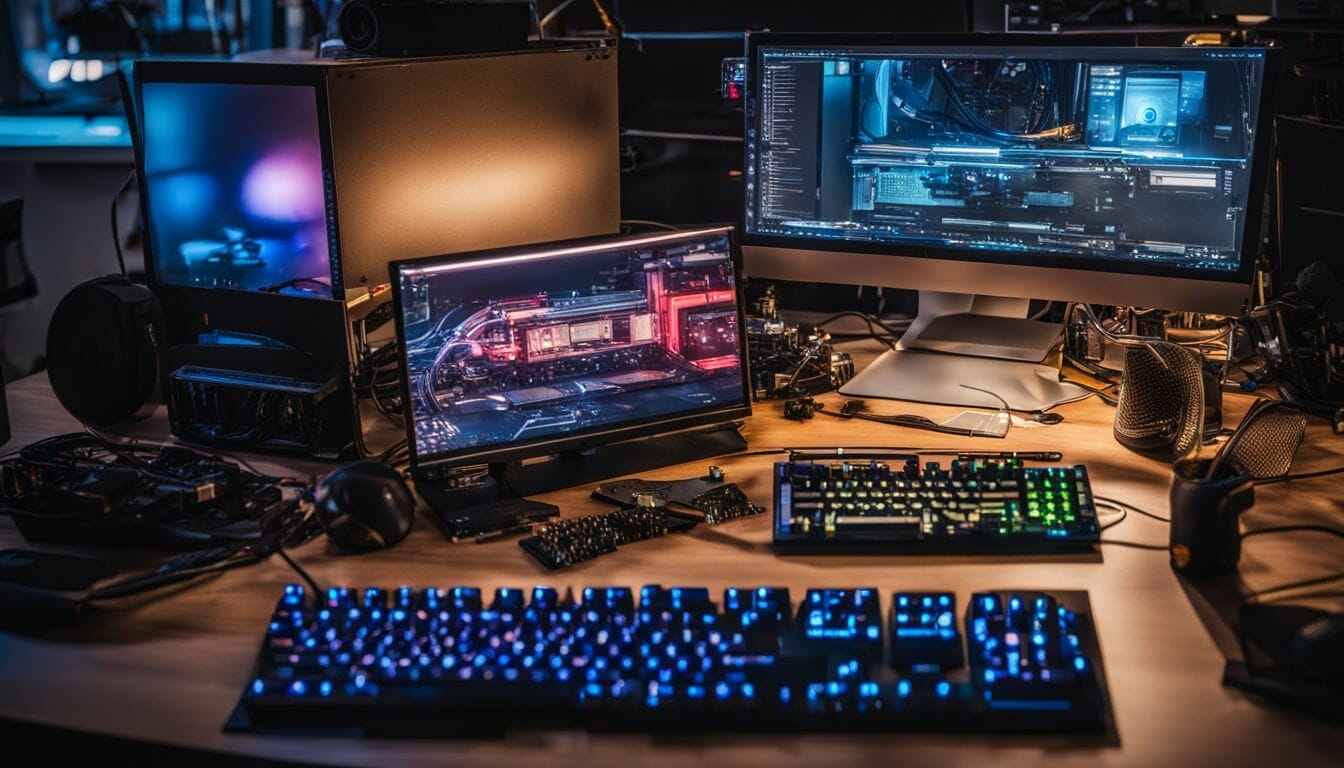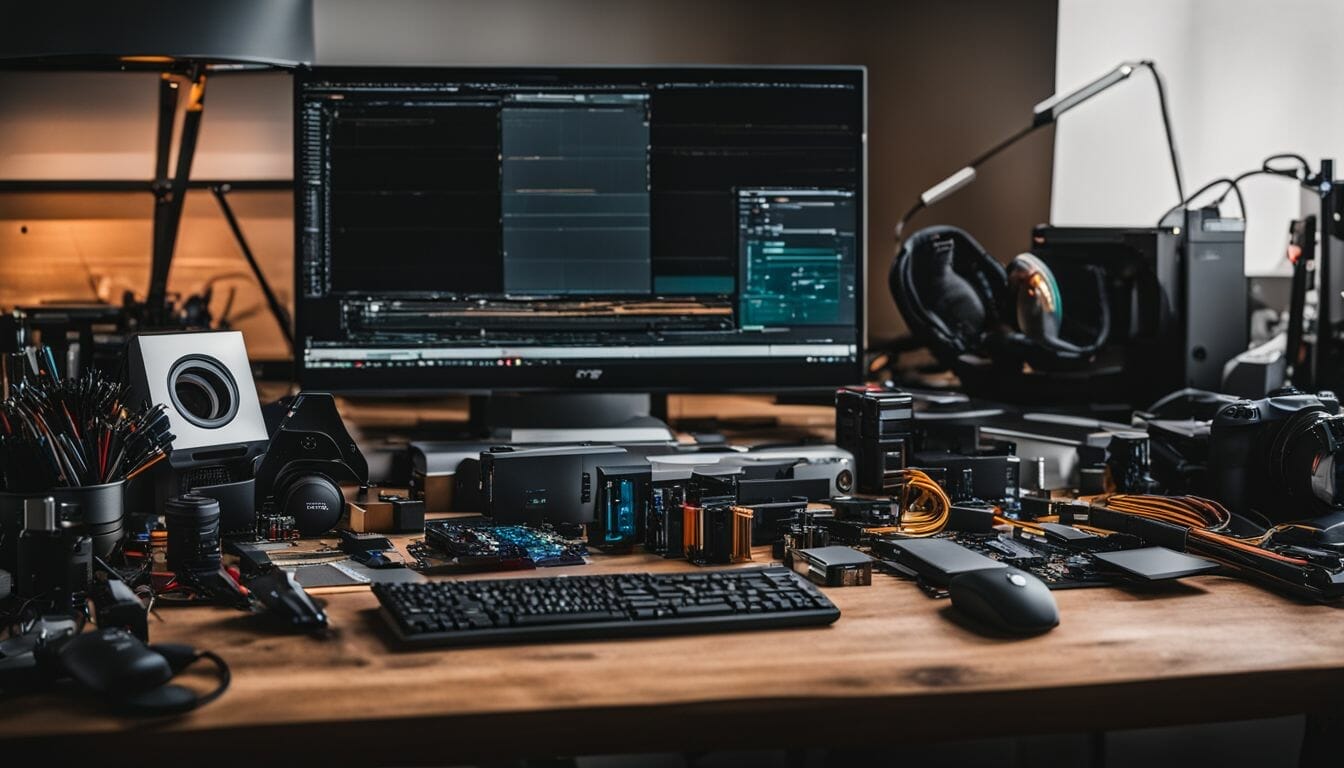Essential Tools for Assembling Your Gaming PC

Many PC gaming enthusiasts dream of creating their personalized computers. However, the notion that certain specific tools are required for this task can seem intimidating. We understand that apprehension; we’ve experienced it too, which is why we committed ourselves to demystify and simplify the construction process for everyone. For an in-depth guide on the essential tools you’ll need to build your ideal gaming PC, take a look at our blog. We cover all the critical components, from fundamental items like screwdrivers to thermal paste, and we even point out handy tools such as needle-nose pliers.
Ready? Let’s dive right into these exciting details..
Key Takeaways
- The essential tools needed to build a PC include a Phillips #2 screwdriver, screw tray, hex nut driver, and flashlight/headlamp.
- Additional recommended tools that can be helpful are an adjustable wrench, hemostat, flathead screwdriver, rubber bands, and vise grip.
- Some nice-to-have tools include an anti-static wrist strap, cable/twist ties for organizing cables, needle-nose pliers for gripping small parts or bending wires, canned air/canless air duster for cleaning dust from components and hard-to-reach areas, and a CPU installation tool.
Essential Tools for PC Building

To successfully build a PC, you will need a few essential tools including a Phillips #2 screwdriver for most screws, a screw tray to keep everything organized, a hex nut driver for securing motherboard standoffs, and a flashlight or headlamp to illuminate tight spaces.
Additionally, if you’re using a non-stock CPU cooler, thermal paste is necessary for proper heat transfer.
Screwdriver (Phillips #2)
We can’t build a PC without a good screwdriver. The Phillips #2 is our tool of choice. It’s the right size for most screws in the computer case. Its tip can hold onto screws well, so they don’t drop and get lost inside.
Sometimes we may need a smaller Phillips #0 for tiny parts like an M.2 device. A handy trick to make work easier is using a magnetic tip screwdriver! They keep screws stuck to the end, reducing slip-ups during hardware assembly and PC maintenance.
Screw tray
A screw tray is a must-have in our PC building toolkit. It keeps all the small parts, like screws, safe and sorted. We never have to worry about losing tiny but important pieces while we work.
Having them in one place makes the whole build process smooth.
We suggest using a magnetic parts tray for an even easier time. It holds onto our screws so they can’t roll away or get lost. Plus, it’s simple to pick up what we need with our Phillips-head screwdriver from this type of tray.
Keeping track of every piece helps us stay organized during assembly! Trust us, a tidy workspace makes hardware builds feel less daunting.
Hex nut driver
A hex nut driver is a must-have in your PC building tools. It looks like a socket wrench but it’s special. You won’t find it easily unless you peek into a computer toolkit. It comes in handy when we are dealing with certain parts of the PC build that other tools can’t reach.
A 5 mm TEKTON one is our go-to choice! With this tool in our kit, we slide past some tricky spots while assembling our gaming rig without any fuss!
Flashlight or headlamp
A flashlight or headlamp is a really handy tool to have when building your PC. It can be difficult to see all the small components and connections, especially in dark areas. Having a bright source of light like a flashlight or headlamp makes it much easier to work on your PC with precision.
Plus, using a headlamp keeps your hands free so you can focus on the task at hand. So make sure to include a flashlight or headlamp in your toolkit for a smooth and well-lit PC building experience!
Thermal paste (if using non-stock CPU cooler)
If you’re using a non-stock CPU cooler in your gaming PC build, it’s important to have some thermal paste. Thermal paste helps with the transfer of heat between the CPU and the cooler, which is crucial for keeping your CPU cool and preventing overheating.
While stock coolers often come with pre-applied thermal paste, it’s still recommended to have your own thermal paste syringe on hand. This way, you can ensure that you have enough and apply it correctly for optimal cooling performance.
So remember, if you’re using a non-stock CPU cooler, don’t forget about the thermal paste!
Additional Recommended Tools for PC Building

Some other tools that are not essential, but can be helpful for building a PC include an adjustable wrench, hemostat, flathead screwdriver, rubber bands, and vise grip.
Adjustable wrench
Another useful tool for PC building is the adjustable wrench. It’s a versatile tool that combines the best elements of pliers and wrenches. The adjustable wrench has smooth-faced jaws that provide a secure grip on fasteners without causing any damage.
What makes it even more convenient is its adjustable jaw, which allows you to use it with different sizes of fasteners. Whether you need to tighten or loosen screws and other fasteners during your PC building process, having an adjustable wrench will make the task much easier.
Hemostat
A hemostat is a useful tool to have when building a PC. It’s like a pocket-sized adjustable wrench with 2mm jaws. We recommend having one because it can come in handy for various tasks during the build process.
Whether you need to hold small parts securely, reach into tight spaces, or even help with cable management, the hemostat can assist you in getting the job done efficiently. So, make sure to include this essential tool in your collection of PC building tools and have it ready when assembling your gaming PC.
Flathead screwdriver
A flathead screwdriver is one of the tools you’ll need when building a PC. It’s used for putting together and taking apart different components during the process. The flathead screwdriver has a slotted head, which means it fits into screws with a straight line across the top.
Some PC hardware might come with Phillips head tools included, but it’s generally recommended to have a separate Phillips Head screwdriver. One option for a good flathead screwdriver is the TEKTON 5 mm screwdriver, which comes highly recommended for building your PC.
Rubber bands
Rubber bands are not commonly considered essential tools for building a PC, but they can be useful in certain situations. While they may not be necessary, they can come in handy when managing cables and wires inside your computer case.
You can use rubber bands to secure and organize cables, preventing them from getting tangled or interfering with other components. This helps with airflow and ensures that your PC runs smoothly.
So, while rubber bands may not be on the top of your list of must-have tools for PC assembly, having a few on hand can make cable management easier and more efficient.
Vise grip
We also recommend having a vise grip when building your PC. This tool can come in handy for holding small parts securely while you work on them, especially if they’re difficult to grasp with your fingers or tweezers.
The vise grip provides a strong and firm hold, allowing you to position and manipulate components without worrying about dropping or damaging them. It’s particularly useful when dealing with delicate cables or connectors that require precise handling during the assembly process.
So make sure to have a vise grip within reach to make your PC building experience smoother and more efficient.
Tools That Are Nice to Have, but Not Strictly Necessary
– An anti-static wrist strap can be useful for preventing electrostatic discharge, but it is not absolutely necessary for building a PC.
– Cable or twist ties are nice to have for organizing cables and keeping them out of the way, but they aren’t essential for the actual assembly process.
– Needle-nose pliers can come in handy for gripping small parts or bending wires, but they are not strictly necessary if you have other tools that can perform similar tasks.
– Canned air or a canless air duster can be helpful for cleaning dust from components and hard-to-reach areas, but you could also use compressed air from a gas station if needed.
– While a CPU installation tool might make installing the processor easier, it is not required as long as you carefully follow the manufacturer’s instructions.
Anti-static wrist strap
When building a PC, one of the tools that can come in handy is an anti-static wrist strap. It helps protect computer components from static shock, which can damage them. While some debate whether it’s necessary for beginners, it provides extra peace of mind.
Alternatives like touching something metal can discharge static electricity, but using an anti-static wrist strap ensures better protection. It’s a simple and affordable tool that minimizes the risk of damaging electronic components due to static electricity during PC assembly or handling.
Cable or twist ties
Cable or twist ties are handy tools to have when building a custom PC. They help keep your cables organized and prevent them from becoming tangled or interfering with other components in the case.
Although not essential, using cable or twist ties can give your finished build a neater and more professional look. These ties are also known as zip ties and are very affordable, making them an easy addition to your toolkit for better cable management.
So, if you want to keep your wires in order and avoid any potential issues, consider investing in some cable or twist ties for your PC building project.
Needle-nose pliers
Needle-nose pliers are handy tools that you might already have in your toolbox at home. They can be useful when building a PC, especially for pc gamers like us. These pliers can help straighten any bent pins on cables or connectors, ensuring everything fits properly.
Additionally, needle-nose pliers come in handy when you need to hold onto small parts or manipulate tiny objects during the building process. If you’re into electrical wiring, jewelry-making, or even floral projects, these pliers are great for shaping wire too.
The Klein J203-8 Heavy Duty Journeyman Pliers are considered the best needle-nose pliers for most people. So having a pair of these around will definitely make your PC building experience easier and more efficient.
Canned air or canless air duster
When cleaning your computer, it’s important to remove dust and dirt efficiently. That’s where canned air or canless air duster comes in handy. These tools are designed to blow out dust from hard-to-reach places like keyboards, vents, and PCBs during assembly.
While aerosol dusters have been commonly used in the past, electric air dusters are now considered a must-have tool. They provide an eco-friendly alternative to compressed air cans which contain harmful refrigerants that can harm the environment and humans.
With a canned air or canless air duster, you can keep your PC clean without the risk of damaging its components or causing harm to yourself or the planet.
CPU installation tool
If you’re building your own PC, you might come across a CPU installation tool. This tool is helpful for installing the processor onto the motherboard. While it’s not strictly necessary, it can make the process easier and more convenient.
The CPU installation tool is considered an affordable option and easy to find in computer repair tool kits. However, if you take proper precautions during assembly, such as ensuring a clean workspace and properly aligning the CPU with the socket, you may not need this tool at all.
So while it’s nice to have, it’s not essential for most PC builders.
Conclusion
To build a PC, you’ll need some essential tools like a Phillips-head screwdriver, screw tray, hex nut driver, and TEKTON 5 mm screwdriver. Other helpful tools include needle-nosed pliers, cable ties for organizing cables, and an anti-static kit to protect sensitive components.
Don’t forget thermal paste for proper heat transfer! And if you want to clean out dust and debris or work in dark areas inside the case, grab a can of air duster and a flashlight. Happy building!
FAQs
1. What tools do I need to build a PC?
To build a PC, you will need basic tools such as a screwdriver (usually Phillips head), cable ties or twist ties, and thermal paste.
2. Do I need any special skills or knowledge to build a PC?
No, building a PC does not require special skills or knowledge. However, it is helpful to have some understanding of computer components and how they fit together.
3. Can I use any screwdriver to build a PC?
Yes, you can use a regular Phillips head screwdriver for most parts of the PC assembly process.
4. Do I need an anti-static wrist strap when building a PC?
While using an anti-static wrist strap is recommended to prevent damage from static electricity, it is not absolutely necessary if you take proper precautions like working on non-carpeted surfaces and touching metal objects before handling sensitive components.
5. Where can I find thermal paste for my PC build?
Thermal paste can be found at computer hardware stores or online retailers that sell computer components.

